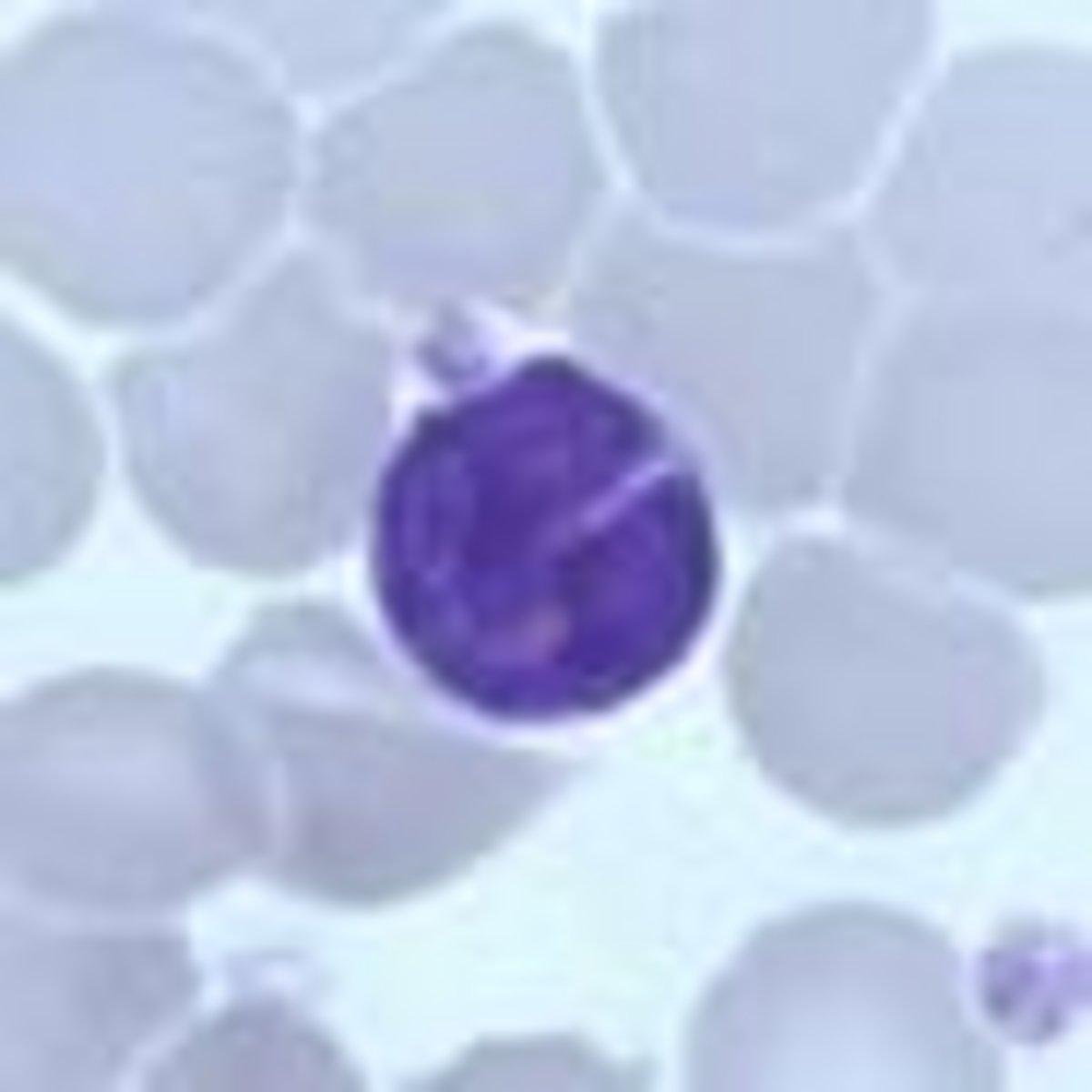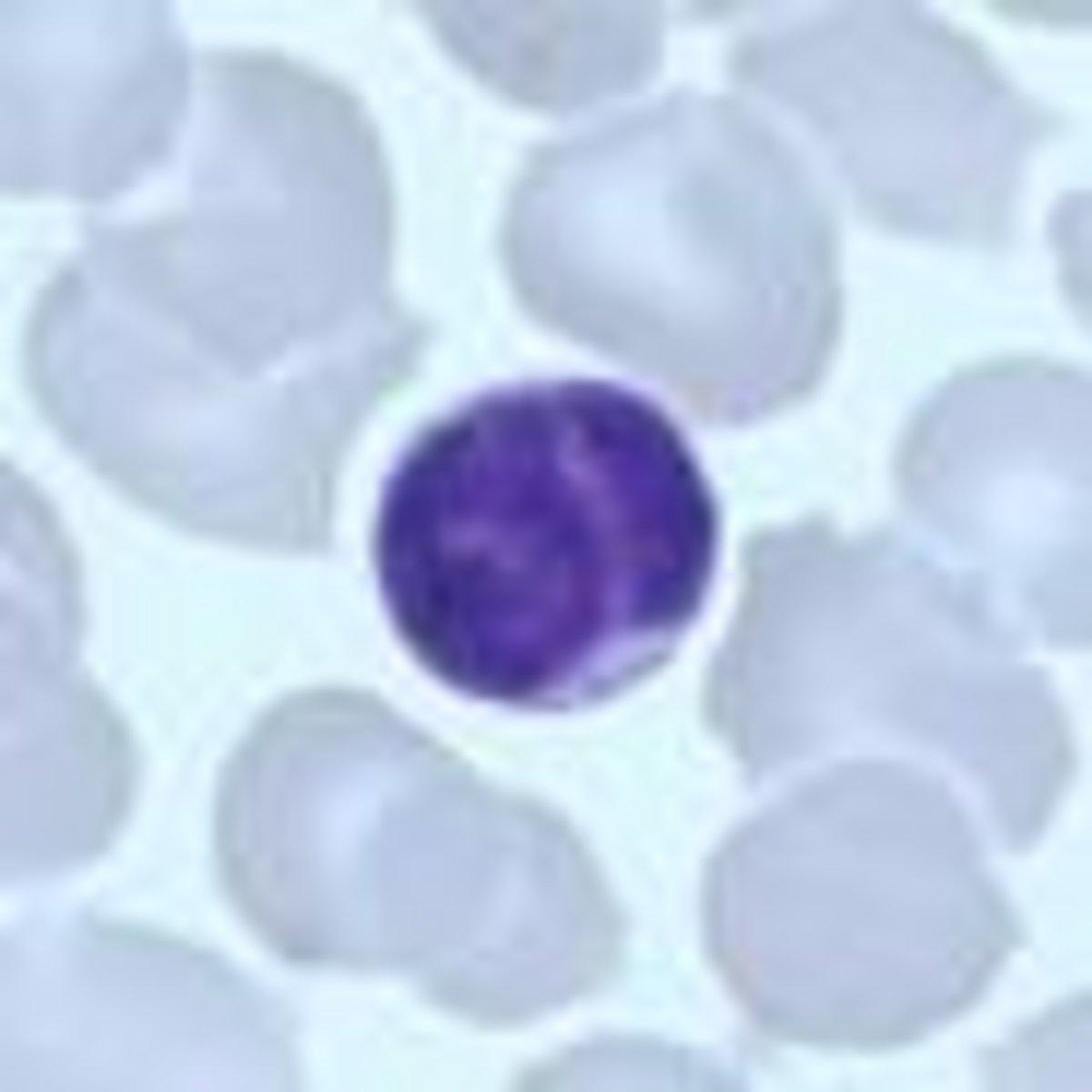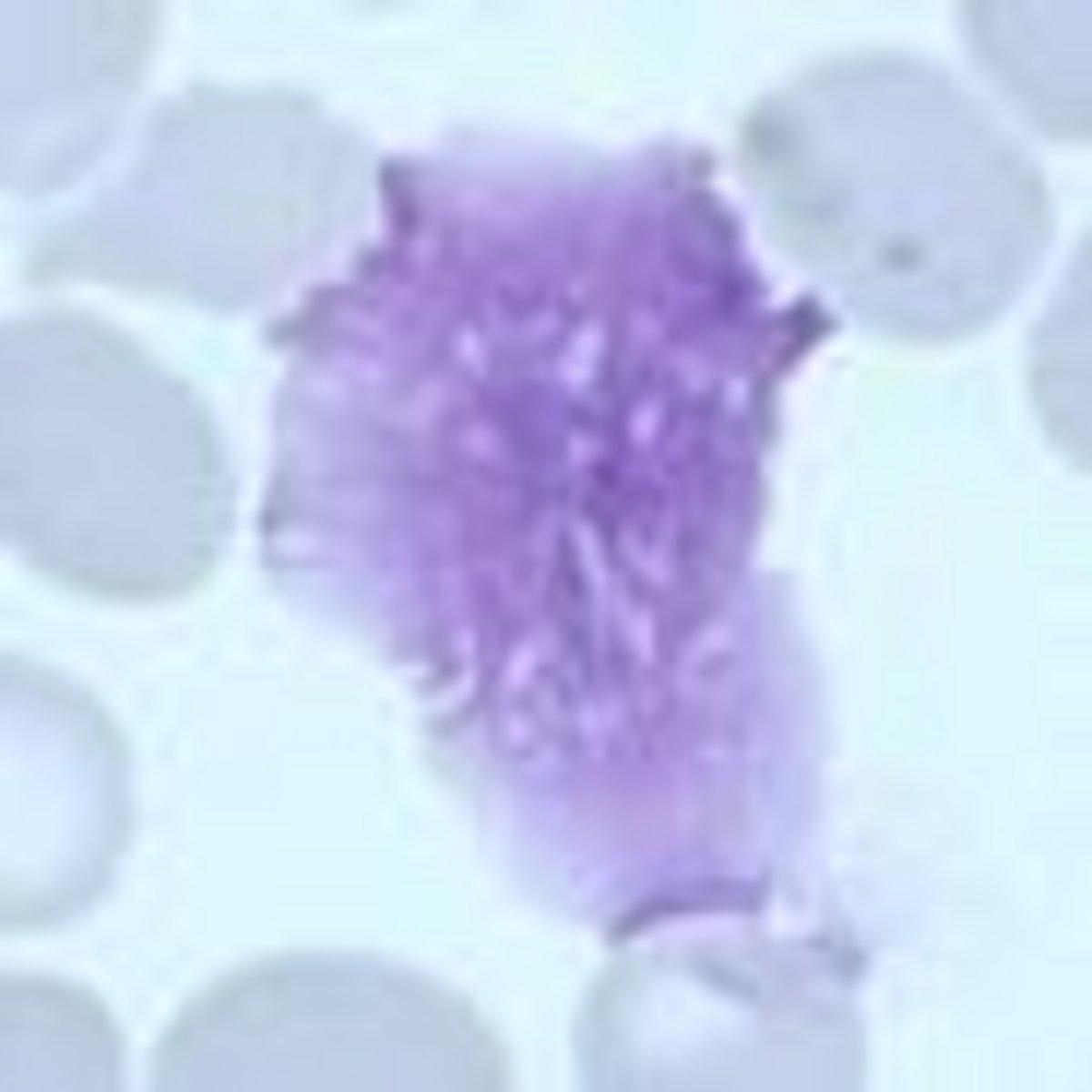

November 2023
Monthly Digital Case Study
November Slides
Matutes score
Anemia
Quiz
(PDF for print)
FBC Results
WBC 26.9* (10^3/mm3)
RBC 5.95* (10^6/mm3)
HGB 17.8* (g/dL)
HCT 54.1* (%)
MCV 91 (fL)
MCH 29.7 (pg)
MCHC 32.7 (g/dL)
PLT 218 (10^3/mm3)
Neutrophils 56.3%
Lymphocytes 40.5%
Monocytes 3.2%
Nuclei Shadows 7
Large Platelets 5
Platelet aggregations 1
Clinical Details
Male 71
Slide Information
Lymphocytosis + "abnormal lymphocytes" flag on analyzer. Monomorphic lymphocytosis with a lymphomatous aspect. The lymphocytes are small in size, with very high nucleo-cytoplasmic ratios and sometimes incised nuclei (deep and narrow incision as on a coffee bean?). Aspect suggestive of a non-Hodgkin's lymphoma (follicular type)? To be compared with the results of blood lymphocyte immunophenotyping by flow cytometry (Matutes scoring and positivity of the CD10 antigen?); and cytogenetic research of the BCL2/IGH t(14;18)(q32;q22) translocation.
Examples of abnormal lymphocytes
Examples of nuclei shadows
Chronic Lymphocytic Leukaemia (CLL) is defined as being a clonal expansion of monomorphic, mature, immunologically incompetent CD5+ B cells in the peripheral blood, bone marrow and secondary lymphoid organs. An accurate diagnosis of B cell CLL is diagnostically important as the therapeutic regimes are different for other B Cell chronic lymphoproliferative disorders. The Matutes score uses immunotyping to identify the presence or expression of certain markers on the surface of the cell. Traditionally 5 markers were used – Surface Immunoglobulin, CD%, CD23, FMC7, and CD22, or CD79b. A scoring system is used for the diagnosis of CLL (see below). In CLL, scores are generally > 3, other B cell malignancies are < 3.
| Marker | Score = 1 | Score = 2 |
| Surface immunoglobulin | Weak | Strong |
| CD5 | Positive | Negative |
| CD23 | Positive | Negative |
| FMC7 | Negative | Positive |
| CD22 or CD79b | Weak | Strong |
Recently an additionally marker - CD200 - has been introduced to increase the accuracy and sensitivity of the score. CD200 is a glycoprotein on the surface membrane of normal B cells, B cell precursors, some T cells, dendritic cells, and neurons. CD200 was first described in 2009 for being always express in CLL but absent in Mantle Cell Lymphoma (MCL). A modified Matutes score was proposed by Jahal in 2021 which incorporates CD200 and also defines better the scoring criteria e.g. CD5 and CD23 score of 1 when the positive cells population <=30%, FMC7 and CD79b score of 1 when the positive cells population <30%. Using this additional marker increased the diagnostic accuracy of the Matutes score to 100%.
CD10 or common ALL antigen (CALLA) is almost always present on the surface of cells from patients with Follicular or Burkitt’s lymphoma. A panel of markers are used to fully diagnose Lymphoma e.g CD20, CD25, CD11c, CD103.
In addition to immunophenotyping, genetic mutation markers are used to assist in the diagnosis and choice of therapy. The genetic mutation BCL2/IGH t(14;18)(q32;q22) translocation is characteristic of Follicular Lymphoma.
The diagnosis of Lymphoproliferative disorders still requires a morphologist to be aware of abnormalities in the Lymphocyte population before any additional testing is performed.
Normal red cells have a Mean Cell Volume (MCV) of between 80 and 100 fL. Any red cells that appear to have a volume larger than this value can be classified as Macrocytic. An increase in MCV is normally associated with an increase in the Mean Cell Hemoglobin (MCH). The MCV is an average of all red cells present therefore some Macrocytic cells may be present even if the MCV is within the normal limits e.g dimorphic picture due to a blood transfusion, increased number of reticulocytes. As a rule, a normal red cell is approximately the same size as the nucleus of a lymphocyte which can be a useful guide in assessing the presence of macrocytic or for that matter microcytic red cells. Blood films should be examined from all patients with abnormal MCV’s to aid in diagnosis of the prime cause.
Macrocytosis may be found in approximately 1.7 - 3.6% of the adult population of which only approximately 40% of were anemic. Approximately 90% of all cases of macrocytosis will be caused by alcohol intake, vitamin B12 and Folate deficiency, chemotherapy and other drugs, hemolysis or bleeding, liver dysfunction, myelodysplastic syndromes, and hypothyroidism. Of the remaining 10% with no obvious cause for the macrocytosis further follow up should be planned.
Excessive alcohol consumption is the biggest cause of macrocytosis in the absence of anemia with the macrocytosis being caused by the direct toxic effect of alcohol on the bone marrow and reduction in the absorption of Vitamin B12 and Folate. Macrocytosis caused by Vitamin B12/ Folate deficiency is often associated with anemia and is the second most common cause of macrocytosis. Vitamin B12 and Folate are essential for the normal maturation of the cell nucleus. In Vitamin B12 or Folate a process known as nuclear cytoplasmic asynchrony occurs which means that the nucleus is developing at a relatively slower pace than hemoglobin is being synthesised, when the cellular hemoglobin concentration reaches a critical point nuclear maturation and division stops and larger red cells are released from the bone marrow. The MCV in cases due to such nuclear maturation defects are normally in the range of 116 to 130fl whereas in the other cases e.g excessive alcohol intake, chemotherapy the MCV is in the range of 100 to 116fL.
The red cells are obviously Macrocytic and often show anisocytosis, poikilocytosis (including the presence of oval macrocytes and teardrop cells), polychromatic cells may not be present, Neutrophil Hypersegmentation is sometimes a feature and is defined as either 5% or more of Neutrophils having 5 lobes or one neutrophil with 6 or more lobes. The presence of oval macrocytes and Hypersegmented neutrophils is highly suggestive of B12 deficiency. As the anemia becomes more severe the anisocytosis and poikilocytosis increases and features of dyserythropoiesis become evident.
Macrocytic red cells and hypersegmented neutrophil
Teardrop poikilocytosis Oval Macrocytes
Bibliography
The significance of unexplained Macrocytosis https://doi.org/10.1182/blood.V112.11.3449.3449
Veda P. Evaluation of macrocytosis in routine hemograms. Indian J Hematol Blood Transfus. 2013 Mar;29(1):26-30. doi: 10.1007/s12288-011-0142-7. Epub 2012 Feb 8. PMID: 24426329; PMCID: PMC3572251.
Kauffmann T, Evans DS. Macrocytosis. [Updated 2022 Sep 26]. In: StatPearls [Internet]. Treasure Island (FL): StatPearls Publishing; 2023 Jan-. Available from: https://www.ncbi.nlm.nih.gov/books/NBK560908
У вас есть вопросы или пожелания? Используйте эту форму, чтобы связаться с нашими специалистами.





